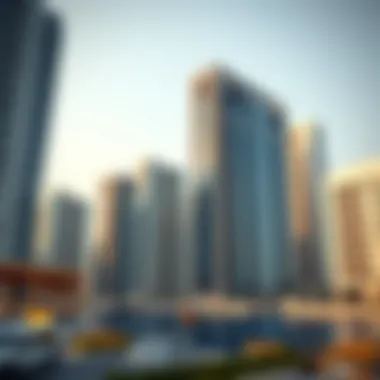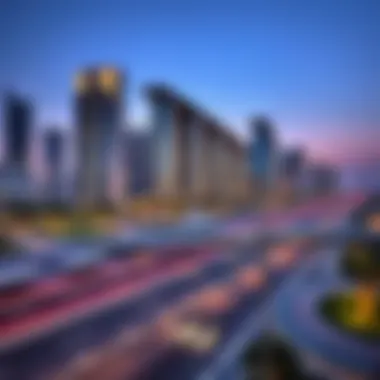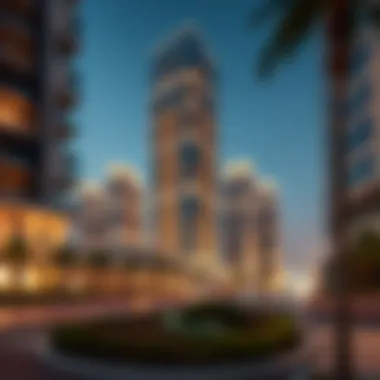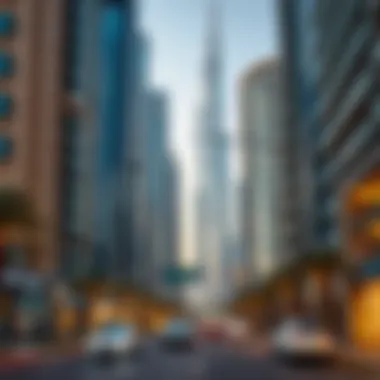Key Developers Shaping Dubai's Real Estate Market


Intro
Dubai's real estate market stands as a beacon of opportunity, illuminated by the ambitious endeavors of several key developers. As this vibrant market continues to expand, understanding the nuances of these developers becomes paramount for anyone looking to venture into property investment.
In this journey through the bustling landscape of Dubai's real estate, we will uncover how the dynamism of leading developers shapes the future of this city. From breathtaking skyscrapers to expansive residential communities, each project reflects the vision of its creator and the underlying trends of the market.
This exploration not only highlights the achievements of major players but also provides insights into the strategies and foresight needed to navigate this competitive arena. Knowledge is power, especially in the fast-paced world of real estate, and being equipped with information can help investors make informed decisions in a thriving sector.
Preamble to Dubai's Real Estate Sector
Dubai's real estate sector stands as a beacon of rapid growth and innovation in the global market. This city has transformed from a modest trading hub to a thriving metropolis, attracting investors and homebuyers from around the world. The importance of understanding the intricacies of Dubai's real estate landscape cannot be overstated for anyone considering a stake in this burgeoning market.
The development within this sector isn't merely about constructing buildings; it encompasses a wider narrative of economic evolution, lifestyle enhancement, and cultural integration. Many investors look toward Dubai not only for its eye-catching skyscrapers but for the comprehensive opportunities the market presents. As such, any examination of the major developers is crucial—they are the architects of this evolution, shaping both the physical infrastructure and the socio-economic fabric of the city.
Historical Context
Understanding the historical context of Dubai's real estate sector provides valuable insights into its current state. In the early 1980s, the Emirate initiated ambitious urban projects to cater to its burgeoning population and diversify its economy beyond oil. The establishment of freehold zones in 2002 was a watershed moment, allowing foreign ownership of property for the first time. This policy shift laid the groundwork for explosive growth by inviting international investment.
As Dubai approached the 2008 global financial crisis, many questioned the sustainability of its real estate boom. Despite these challenges, the sector displayed resilience, recovering rapidly and adapting to the new market dynamics. Now, historical lessons inform current strategies, with developers focusing more on sustainability and affordability, aligned with government initiatives, such as Vision 2021.
Current Market Trends
Today, the Dubai real estate market is characterized by several noteworthy trends. One of the standout features is the increasing demand for luxury properties. Wealthy buyers from Asia, Europe, and beyond are increasingly seeking premium residential options, fuelled by favorable visa policies and the city's livability.
Moreover, the pandemic accelerated the adoption of smart home technologies, with developers incorporating these features to cater to tech-savvy buyers. The preference for spacious homes with outdoor areas has also tipped the scales towards suburban developments.
Interestingly, sustainability has taken center stage, with developers investing heavily in green practices. Many are implementing eco-friendly designs, energy-efficient solutions, and integrating open spaces into their projects, thereby meeting evolving consumer expectations.
"Investors are looking for properties that not only offer luxury but also a commitment to sustainable development."
Finally, the market is seeing a gradual shift towards affordable housing, as the government pushes for more inclusive living options. With these trends, prospective investors and buyers can navigate the landscape with a well-rounded perspective, allowing them to make informed decisions amid the dynamic ebb and flow of Dubai’s real estate sector.
For further insights, you may refer to insights from organizations like Dubai Land Department or reports on current market trends from KPMG.
Major Developers Shaping Dubai
Dubai’s real estate landscape is a patchwork of innovation, ambition, and undeniable transformation. Major developers are the engine behind this architectural marvel, each contributing a unique flavor to the fabric of the city. They are not merely builders; they create communities, fuel economic growth, and redefine living standards one project at a time. Investors, buyers, and renters keen on entering this market must understand the implications and advantages these developers bring.
Emaar Properties
Emaar Properties sits at the forefront of Dubai’s architectural innovations. Known for its monumental developments, Emaar's projects reflect luxury and modern living. They not only construct buildings but sculpt lifestyles.
Key projects and contributions
Emaar's flagship project, the Burj Khalifa, stands as a testament to its capabilities. But beyond just height, its contributions extend to places like the Dubai Mall, which is not just a shopping destination but an entertainment hub. This combination of retail and leisure makes it a beacon for tourists and locals alike. The significance of these projects lies in their ability to enhance living experiences. With a focus on creating vibrant spaces, Emaar ensures that its projects aren't just structures, but rather ways of life.
Impact on community development


By focusing heavily on community development, Emaar creates neighborhoods that foster connections among residents. Their developments often include parks, schools, and recreational facilities, ensuring that a wholesome environment thrives. Such amenities make the properties more appealing, casting Emaar as a leader in thoughtful urban planning. However, it’s essential to consider that this also attracts a higher price tag, which may not suit every potential buyer.
Future projects and innovations
Looking ahead, Emaar is diving into smart technologies and sustainable practices. With projects aimed at integrating the principles of smart living, they are setting the stage for future trends. These innovations not only elevate the living experience but also address modern challenges of urban living, making Emaar a go-to choice for forward-thinking buyers. Still, with innovation comes cost, and potential investors should tread carefully, ensuring that sustainability is indeed a priority over profit.
DAMAC Properties
In the luxury sector, DAMAC Properties has carved out a niche that reflects opulence and high-end designs. They understand that luxury is not just a price point but an experience.
Signature developments
Signature developments like the Aykon City embody the essence of lavish living. Positioned to combine residential, commercial, and hospitality, these developments promote a cohesive lifestyle. The unique selling point here is the attention to detail and quality, making DAMAC a popular choice for affluent buyers. However, this focus on luxury can sometimes overlook the more budget-conscious consumers in the market.
Luxury market positioning
DAMAC has perfected the art of luxury market positioning. By partnering with high-profile designers and brands, such as Versace and Fendi for interiors, they cater to individuals who seek not just a home but a statement. While this strategy creates buzz and desirability, it also creates a market perceived as exclusive—only accessible to those with considerable financial means.
Partnerships and collaborations
Strategic partnerships, such as those with international hospitality brands, allow DAMAC to broaden its appeal. These ventures not only bolster their portfolio but also enrich the lifestyle offerings at their developments. Each partnership adds credibility, but investors must also scrutinize whether the realized benefits outweigh potential market saturation as luxury becomes more ubiquitous.
Nakheel
Nakheel has garnered attention for its audacious projects that have reshaped the coastline of Dubai. Their developments speak to human creativity and ambition in urban planning.
Iconic developments such as Palm Jumeirah
Perhaps their most famous project, Palm Jumeirah, is a symbol of architectural daring. This man-made island has not only become a luxurious residential area but also a global tourism icon. Its distinct design is a driving force for visitors and residents alike. However, the high-profile nature of such projects comes with environmental concerns that Nakheel must continue to address in future endeavors.
Sustainability initiatives
In an age that calls for environmental accountability, Nakheel is stepping up with sustainable initiatives. This includes efforts to incorporate natural elements into their designs and reduce carbon footprints. The challenge lies in balancing growth while ensuring ecological responsibility, an endeavor that appeals to a growing demographic concerned about sustainability.
Future vision and projects
Nakheel's future vision aims at enhancing Dubai’s appeal as a global destination while considering practicality in design. Their projects are expected to focus on community integration and enhancing lifestyle without compromising sustainability. Investors should keep a keen eye on how these developments evolve, especially in light of climate considerations impacting the property market.
Meraas
Meraas thrived on creating inviting spaces that combine community living with urban vibrancy. They consider the human element with every project, making them a valuable player in Dubai.
Community-focused projects
Their commitment to community-centered projects stands out. Developments like City Walk exemplify their ethos, blending residential areas with retail and entertainment. This strategy ensures that neighborhoods are not just about living but thriving. However, the mix of commercial and residential can create parking and congestion challenges, which may deter certain residents.
Urban development strategies
Meraas employs innovative urban development strategies that promote inclusivity and accessibility. By integrating parks and green spaces, they enhance urban biodiversity, which is increasingly becoming an expectation in contemporary living. But, maintaining these spaces requires ongoing investment, posing questions on long-term sustainability.


Contribution to tourism and lifestyle
The lifestyle projects that Meraas spearheads, like the attraction-filled Bluewater Island, contribute significantly to Dubai's tourism. Meraas understands that lifestyle offerings attract both local and foreign investment, further cementing their position in the market. The challenge remains in keeping these attractions fresh and relevant to avoid becoming stale in a constantly evolving market.
Azizi Developments
Azizi Developments is focused on delivering quality without breaking the bank. Their emphasis on affordable housing sets them apart in a rapidly globalizing market.
Affordable housing initiatives
By prioritizing affordable housing, Azizi is addressing a crucial gap in Dubai’s property market. Projects designed for first-time buyers aim to make luxurious living achievable without the exorbitant price tag often associated with Dubai. However, affordability should not compromise quality; that balance is something prospective investors must watch closely.
Quality and design standards
Azizi is committed to maintaining high quality and design standards, evident in their aesthetically pleasing developments. This dedication not only attracts buyers but builds a reputation as trustworthy in a competitive landscape. Although high design expectations can strain budgets, staying true to quality can foster lasting customer loyalty.
Market position and future growth
With an eye on growth, Azizi is positioning itself wisely in emerging areas. The focus on infill development and tapping into new neighborhoods ensures they remain relevant. However, staying adaptable in the face of market dynamics will be critical for their success as consumer expectations evolve.
Investment Opportunities in Dubai's Real Estate
Dubai's real estate sector has blossomed into a vital playground for investors. The city has a reputation for luxury living, innovative architecture, and a continually evolving urban landscape. This section delves into the investment opportunities within this vibrant market, drawing attention to emerging neighborhoods and market stability. By understanding these elements, investors can position themselves strategically, maximizing their potential returns and aligning with market trends.
Emerging Neighborhoods
As the city continues to expand, new neighborhoods are popping up like mushrooms after rain. These areas are becoming prime spots for investment due to several factors that are redefining the real estate landscape.
Trends influencing neighborhoods
In recent years, several trends have influenced the development of neighborhoods in Dubai. The rise of remote working has led to increased demand for larger residential spaces as people look for homes that offer both comfort and functionality. As a result, areas such as Dubai Hills Estate and Dubai Marina are gaining popularity due to their lifestyle offerings and convenient amenities. These locations boast parks, schools, and retail hubs, making them appealing for families and young professionals alike.
One specific characteristic making these neighborhoods attractive is their integration of nature with urban living. Today's buyers show a marked preference for greener spaces, leading developers to invest in extensive landscaping and parks. Such features not only enhance the aesthetic appeal but also promote health and well-being, tapping into the growing demand for community-oriented living.
Potential returns on investment
Investing in emerging neighborhoods can yield significant returns. Properties in these areas may initially come at a lower price point, which could mean greater room for appreciation as demand increases. As infrastructure improves and businesses pop up, property owners are likely to see their investments paying off handsomely in the long run. Investors should take the time to research which areas are slated for future development, as these can sometimes offer the best bang for the buck.
For example, suburbs like Jumeirah Village Circle and Dubai South are expected to undergo major transformations, potentially doubling property values in just a few years. The unique selling proposition here is the sweet spot: lower initial investment with the likelihood of rapid appreciation in value.
Market Stability
Stability is vital when considering investment opportunities, especially in a market as dynamic as Dubai's. Stable markets allow investors to make informed decisions and anticipate future trends without excessive risk.
Regulatory environment
The regulatory environment in Dubai is continually evolving, aimed at attracting foreign investment while ensuring consumer protection. Initiatives such as the introduction of long-term visas for property investors signify a commitment to making Dubai a haven for property buyers. Additionally, laws have been passed to safeguard investors, simplifying the buying process and providing a framework that enhances transparency.
These regulations sway potential investors by creating a safe environment, inherently lowering risks. With a robust legal framework, investors can confidently venture into the market, aware that their rights are protected and the rules are clear.


Long-term investment prospects
When it comes to long-term investment prospects, Dubai offers compelling reasons for investors to bet on its real estate market. Historical data shows consistent growth, making it a hotspot for those looking to establish a sound investment portfolio. The city's strategic location and global appeal further cement its position as a lucrative real estate market.
Investing in Dubai's real estate today can yield benefits for years, as upcoming projects such as the Expo 2020 site look to reshape neighborhoods and enhance the city’s infrastructure. The long-term vision of the city's leadership, combined with its aspirations for smart city initiatives, suggest a bright future for investors willing to look beyond the current trends.
Future Outlook for Dubai's Real Estate Developers
The future of Dubai's real estate developers is painted with opportunities and challenges, reflecting the evolving landscape of urbanization, technology, and sustainability. The importance of understanding this outlook lies in its potential to guide prospective buyers, investors, and stakeholders in making informed decisions. By examining how these developers adapt to changing trends and the dynamic nature of the market, one gets a clearer picture of where the sector is heading.
Technological Integration
Smart cities and innovations
Smart cities are becoming a showcase for innovation in Dubai, merging technology with urban living. A key aspect is the implementation of Internet of Things (IoT) solutions in residential properties, which allows homeowners to control lighting, security, and energy consumption from their smartphones. This integration not only enhances convenience but also fosters a more efficient use of resources, paving the way for sustainable living.
One hallmark of these smart developments is the focus on connectivity. Buildings outfitted with integrated technologies can reduce costs and create a better living experience for residents. However, the reliance on technology poses risks such as data privacy concerns. Thus, while smart cities present numerous benefits, they also call for careful consideration and robust cybersecurity measures to protect residents' information.
Impact on buyer preferences
The increasing trend towards smart homes has shifted buyer preferences significantly. Today, buyers are more inclined to seek properties that offer innovative features that promise efficiency and sustainability. This systemic change highlights a key characteristic of modern real estate: the dual demand for luxury living and technological capability.
With the availability of smart home technologies, buyers enjoy unique benefits, such as energy-efficient appliances that can lead to reduced utility bills. On the downside, there is a higher initial investment in properties that incorporate these technologies, which may deter some traditional buyers. Nevertheless, the long-term savings coupled with enhanced living experiences often outweigh the upfront costs. As the market adapts to these shifting preferences, developers will likely continue to innovate in order to remain competitive.
Sustainability Trends
Green building practices
Green building practices are gaining momentum in Dubai, responding to the urgent need for environmentally responsible construction. A significant aspect of this movement is the emphasis on using sustainable materials and operational energy efficiency. Developers, by adopting green building certifications like LEED (Leadership in Energy and Environmental Design), signal their commitment to sustainability.
The appeal of green buildings lies in their dual impact: they not only contribute positively to the environment but also often translate to significant savings in energy costs for homeowners. However, the challenge remains that the initial investment for sustainable construction materials can be higher than traditional options. Despite this, the demand for green buildings continues to rise as awareness of environmental issues grows among buyers, pushing developers to enhance their sustainability commitments.
Market demand for eco-friendly developments
The demand for eco-friendly developments is not merely a trend; it's a paradigm shift among buyers in Dubai. With the younger generation placing high value on environmental stewardship, developers are responding by integrating sustainable practices into their projects. This shift presents a distinct opportunity for developers to create properties that resonate with modern sensibilities.
One defining characteristic of this market demand is the increasing expectation for transparency in how buildings are constructed and maintained. Buyers now seek assurance that their investments contribute to a larger goal of environmental preservation. Developers meeting these expectations not only gain a competitive edge but also foster community trust. However, maintaining that balance can be tricky, as buyers may have differing expectations on what truly constitutes eco-friendliness.
In closing, the outlook for Dubai's real estate developers is poised to be shaped significantly by technological integration and a commitment to sustainability. Understanding these elements is crucial for any stakeholder looking to navigate the intricacies of the real estate market in this vibrant city.
The End
The conclusion serves as a crucial component of any analysis, providing a synthesizing reflection on the subject at hand. In the context of Dubai's real estate landscape, it encapsulates the profound impact that major developers have on shaping the market dynamics and investment opportunities. By understanding the roles played by developers like Emaar Properties and DAMAC Properties, investors can appreciate how these entities drive growth and innovation. The insights into their projects and contributions lay the groundwork for identifying potential areas of investment and future developments.
Summarizing the Developers' Impact
The influence of developers in Dubai extends beyond mere brick and mortar; it fundamentally alters the living experience of countless residents and the economic framework of the city. Developers in the area have crafted not only high-end residential towers but also community hubs and vibrant public spaces. Each developer’s emphasis on sustainability, luxury living, and future-centric designs helps create an interwoven fabric of modern life in Dubai.
- Community Development: Places like Palm Jumeirah show how developers incorporate lifestyle amenities that cater not just to residents but also boost tourism.
- Economic Contributions: The real estate sector generated significant revenue flow, underpinning Dubai's status as a thriving business hub.
- Market Trends: These developers are swaying buyer preferences towards more modern yet sustainable living environments, indicating a shift from traditional to contemporary architecture.
"The face of Dubai's skyline is a tapestry woven by its greatest developers, each thread representing innovation and ambition."
Considerations for Prospective Buyers
For potential investors eyeing opportunities in Dubai, several factors should be front of mind. Firstly, understanding market stability is paramount. Prospective buyers should analyze the current regulations, which can provide a framework for predicting future market performance. Here are a few considerations to keep in mind:
- Research Recent Developments: Keeping an eye on emerging neighborhoods such as Dubai Hills Estate can yield insights into possible future value increases.
- Investment Viability: Look beyond just residential properties; mixed-use developments often provide broader investment horizons.
- Long-term Potential: Engage in thorough due diligence—it pays to know the historical performance of areas where you plan to invest.
The conclusion ties together the crucial elements discussed in the article, reinforcing the idea that understanding the key players in Dubai's real estate market is essential for making informed investment decisions. As the sector continues to evolve with trends such as smart buildings and eco-friendly practices, staying abreast of these developments is vital for anyone looking to enter this thriving market.



